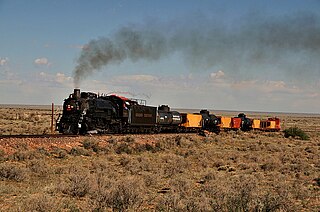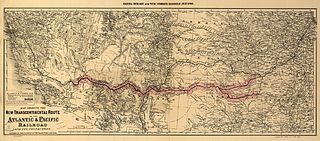The Crosbyton-South Plains Railroad, also known as the South Plains and Santa Fe railroad, was a railroad which operated from Crosbyton, Texas, to Lubbock, Texas, between the years of 1910 and 1948.
The Crosbyton-South Plains Railroad, also known as the South Plains and Santa Fe railroad, was a railroad which operated from Crosbyton, Texas, to Lubbock, Texas, between the years of 1910 and 1948.
The railroad was chartered on April 6, 1910. The initial capital was $150,000 and the first board of directors consisted of Julian M. Bassett, Roger M. Bassett, William D. Petzel, and Joseph C. Johnson, of Crosbyton, Texas; Avery Coonley of Riverside, Illinois; and John S. Coonley and Prentiss L. Coonley, of Chicago, Illinois with the principal office located in Crosbyton. The intent was to construct two lines, totaling 120 miles. The first line was to run Crosbyton to Lubbock, Texas, and the second from Crosbyton to Plainview, Texas. [1] The Crosbyton to Lubbock line was completed in early 1911 and consisted of 38.4 miles of main line track and 5.2 miles of yard track and sidings. Construction never began on the second line from Crosbyton to Plainview. The Crosbyton-South Plains' first run occurred on April 10, 1911, departing from Crosbyton with service to Lubbock. [2] The nearly 39 mile long line ran through the towns of Ralls, Texas, Lorenzo, Texas, and Idalou, Texas, before reaching Lubbock. At its peak, the Crosbyton-South Plains operated one steam locomotive, 2 passenger cars and 2 freight cars. [3]
In 1912, the railroad was ordered to construct a depot in Ralls by the Railroad Commission. [4]
On August 1, 1915, the Atchison, Topeka and Santa Fe Railroad purchased Crosbyton-South Plains, later renaming it to the South Plains and Santa Fe Railroad on August 17, 1916. At this point in time, the principal office was moved to Lubbock, with the board of directors including Atchison, Topeka and Santa Fe Railway President E. P. Ripley. [1]
On July 1, 1917, the Panhandle and Santa Fe Railroad leased the original C-SP line, along with all of Atchison, Topeka and Santa Fe's other holdings. Operations continued until 1948 when the Panhandle and Santa Fe Railroad merged with the parent company, the Santa Fe Railway. The former South Plains and Santa Fe holdings were disposed by Santa Fe, bringing about the end of the original Crosbyton-South Plains Railroad. [5]
In January 1990, the original Crosbyton-South Plains line was sold to the Crosbyton Railroad. Operations ceased in under one year due to a lack of business. [5]
Today, remnants of the original Crosbyton-South Plains Railroad can still be found in and around Lubbock, Texas. Pieces of the main line to the West, once running to Crosbyton, can still be seen along East Municipal Drive in Lubbock. Main line track still exists, connecting to the Burlington Northern & Santa Fe Railway lines running through Lubbock. Not much else is left of the original Crosbyton-South Plains Railroad.

Marion County is a county located in the U.S. state of Kansas. Its county seat is Marion and its most populous city is Hillsboro. As of the 2020 census, the county population was 12,660. The county was named in honor of Francis Marion, a brigadier general of the American Revolutionary War, known as the "Swamp Fox".

Strong City is a city in Chase County, Kansas, United States. Originally known as Cottonwood Station, in 1881 it was renamed Strong City after William Barstow Strong, then vice-president and general manager, and later president of the Atchison, Topeka and Santa Fe Railway. As of the 2020 census, the population of the city was 386. It is located along U.S. Route 50 highway.

Wilson is a small rural city in the northeastern quadrant of Lynn County, Texas, United States. As of the 2010 census, the population was 489.

The Atchison, Topeka and Santa Fe Railway, often referred to as the Santa Fe or AT&SF, was one of the larger railroads in the United States. The railroad was chartered in February 1859 to serve the cities of Atchison and Topeka, Kansas, and Santa Fe, New Mexico. The railroad reached the Kansas–Colorado border in 1873 and Pueblo, Colorado, in 1876. To create a demand for its services, the railroad set up real estate offices and sold farmland from the land grants that it was awarded by Congress.

The Grand Canyon Railway is a heritage railroad which carries passengers between Williams, Arizona, and the South Rim of Grand Canyon National Park.

The Atlantic and Pacific Railroad was a U.S. railroad that owned or operated two disjointed segments, one connecting St. Louis, Missouri with Tulsa, Oklahoma, and the other connecting Albuquerque, New Mexico with Needles in Southern California. It was incorporated by the U.S. Congress in 1866 as a transcontinental railroad connecting Springfield, Missouri and Van Buren, Arkansas with California. The central portion was never constructed, and the two halves later became parts of the St. Louis-San Francisco Railway and Atchison, Topeka and Santa Fe Railway systems, now both merged into the BNSF Railway.

The Gulf, Colorado and Santa Fe Railway was a subsidiary of the Atchison, Topeka & Santa Fe Railway. From its starting point in Galveston, Texas, the railroad eventually extended northwestwards across the state to Sweetwater and northwards via Fort Worth to Purcell, Oklahoma.

The Panhandle and Santa Fe Railway (P&SF) is a now-defunct railroad company that was a subsidiary of the Atchison, Topeka and Santa Fe Railway (AT&SF), operating primarily in the Texas Panhandle.
The Denver, Enid and Gulf Railroad (DE&G) was built as a short line railroad operating in Kansas, and Oklahoma. Incorporated in Oklahoma as the Denver, Enid and Gulf Railroad Company, March 31, 1902, by the five Frantz Brothers.

The Caprock Chief or Caprock Xpress was a proposed Amtrak inter-city rail service which would run from Fort Worth, Texas to Denver, Colorado, passing through the Texas Panhandle, which currently does not have passenger rail service of any kind. Initially proposed 2000–2001, the project has not yet seen significant progress and is unlikely to be implemented. "Caprock" is a geological term for a harder or more resistant rock type overlying a weaker or less resistant rock type, and lends its name to the Caprock Escarpment that defines the edge of the high plains of the Llano Estacado.

Santa Fe Depot is the northern terminus of the New Mexico Rail Runner Express commuter rail line. The station was originally built by the Atchison, Topeka and Santa Fe, and until 2014 served as the northern terminus, offices, and gift shop of the Santa Fe Southern Railway, a tourist and freight carrying short line railroad. It is located in Santa Fe, New Mexico at 410 Guadalupe Street, within an area of urban renewal referred to as the "Railyard". Rail Runner service to the station began on December 17, 2008.

The Southern Transcon is a main line of BNSF Railway comprising 11 subdivisions between Southern California and Chicago, Illinois. Completed in its current alignment in 1908 by the Atchison, Topeka and Santa Fe Railway, when it opened the Belen Cutoff in New Mexico and bypassed the steep grades of Raton Pass, it now serves as a mostly double-tracked intermodal corridor.

The West Texas & Lubbock Railway is a shortline railroad in Texas, owned by Watco. It connects the BNSF in Lubbock with agricultural and oil-producing areas to the west and southwest. The company operates 107 miles of two ex-Atchison, Topeka & Santa Fe Railway lines, extending to Whiteface and Seagraves parallel to State Highway 114 and U.S. Highway 62. The primary commodities hauled are fertilizer, construction aggregates, grain, cotton, chemicals, peanuts and plastics.
Atchison, Topeka and Santa Fe Railway Depot, or variations with Railroad or Station or Passenger and/or Freight may refer to any one of many stations of the Atchison, Topeka and Santa Fe Railway. These include:
The Panhandle Northern Railroad is a class III short-line railroad that operates 31 miles of track between Borger, Texas and Panhandle, Texas. The line operates on former Atchison, Topeka and Santa Fe Railway trackage that was sold off in 1993. It is owned by OmniTRAX.

The Fort Worth and Rio Grande Railway, chartered under the laws of Texas on June 1, 1885, was part of a plan conceived by Buckley Burton Paddock and other Fort Worth civic leaders to create a transcontinental route linking New York, Fort Worth, and the Pacific port of Topolobampo, which they believed would stimulate the growth and development of southwest Texas in general, and the economy of Fort Worth in particular.

Galesburg Santa Fe Station was a railway station in the west central Illinois town of Galesburg. The station was along the Atchison, Topeka and Santa Fe Railway's main line and served trains such as the Super Chief and El Captain. After Amtrak took over intercity rail in the United States, it was served by trains such as the Lone Star (1971–1979) and the Southwest Chief (1971–1996).

Posey is a small, unincorporated, community located on the level plains of the Llano Estacado about 11 mi (18 km) southeast of Lubbock in southeastern Lubbock County, Texas.
Edward Alfred Harrison, known as E. A. Harrison, was an American architect who worked as a staff architect for the Atchison, Topeka & Santa Fe Railway, with offices in Topeka, Kansas, and later in Chicago, Illinois.
The Clinton and Oklahoma Western Railroad was a railway in southwestern Oklahoma and the Texas Panhandle, with a mainline eventually running from Clinton, Oklahoma to Pampa, Texas, about 139 miles. The predecessor company was incorporated in 1908, and the railroad was merged out of existence in 1948.